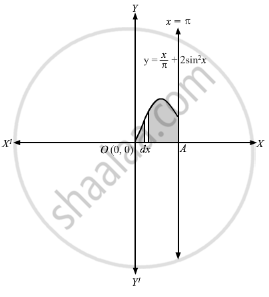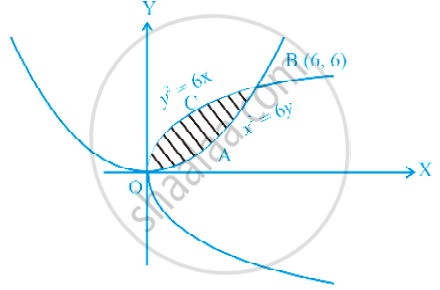Advertisements
Advertisements
Question
Draw a rough sketch of the curve \[y = \frac{x}{\pi} + 2 \sin^2 x\] and find the area between the x-axis, the curve and the ordinates x = 0 and x = π.
Solution

The table for different values of x and y is
| X | 0 | `pi/6` | `pi/2` | `(5pi)/6` | `pi` |
| sin x | 0 | `1/2` | 1 | `1/2` | 0 |
| \[y = \frac{\pi}{2} + 2 \sin^2 x\] | 0 | `2/3` | `5/2` | `4/3` | 1 |
\[y = \frac{x}{\pi} + 2 \sin^2 x ,\text{ is an arc cutting }y -\text{ axis at O(0, 0) and cutting }x = \pi \text{ at } \left( \pi, 1 \right)\]
\[\text{ Consider a vertical strip of length }= \left| y \right| \text{ and width }= dx \text{ in the first quadrant }\]
\[ \therefore\text{ Area of approximating rectangle }= \left| y \right| dx\]
\[\text{ The approximating rectangle moves from }x = 0\text{ to }x = \pi\]
\[ \Rightarrow\text{ Area of the shaded area }= \int_0^\pi \left| y \right| dx\]
\[ \Rightarrow A = \int_0^\pi y dx ..............\left\{ As, y > 0 \Rightarrow \left| y \right| = y \right\}\]
\[ \Rightarrow A = \int_0^\pi \left( \frac{x}{\pi} + 2 \sin^2 x \right) dx\]
\[ \Rightarrow A = \frac{1}{\pi} \int_0^\pi x dx + 2 \int_0^\pi \sin^2 x dx\]
\[ \Rightarrow A = \frac{1}{\pi} \left[ \frac{x^2}{2} \right]_0^\pi + 2 \left[ \frac{x}{2} - \frac{1}{2}\sin x \cos x \right]_0^\pi \]
\[ \Rightarrow A = \frac{\pi^2}{2\pi} + \frac{2}{2}\left[ \pi - \frac{1}{2}\sin \pi \cos \pi - 0 \right]\]
\[ \Rightarrow A = \frac{\pi}{2} + \pi\]
\[ \Rightarrow A = \frac{3\pi}{2}\text{ sq . units }\]
\[ \therefore\text{ Area of the curve enclosed between }x = 0\text{ and }x = \pi\text{ is }\frac{3\pi}{2}\text{ sq . units }\]
APPEARS IN
RELATED QUESTIONS
Find the area of the region lying in the first quandrant bounded by the curve y2= 4x, X axis and the lines x = 1, x = 4
Using integration, find the area of the region bounded by the line y − 1 = x, the x − axis and the ordinates x= −2 and x = 3.
Determine the area under the curve y = \[\sqrt{a^2 - x^2}\] included between the lines x = 0 and x = a.
Using definite integrals, find the area of the circle x2 + y2 = a2.
Find the area bounded by the ellipse \[\frac{x^2}{a^2} + \frac{y^2}{b^2} = 1\] and the ordinates x = ae and x = 0, where b2 = a2 (1 − e2) and e < 1.
Find the area of the region bounded by the curve \[x = a t^2 , y = 2\text{ at }\]between the ordinates corresponding t = 1 and t = 2.
Prove that the area in the first quadrant enclosed by the x-axis, the line x = \[\sqrt{3}y\] and the circle x2 + y2 = 4 is π/3.
Find the area common to the circle x2 + y2 = 16 a2 and the parabola y2 = 6 ax.
OR
Find the area of the region {(x, y) : y2 ≤ 6ax} and {(x, y) : x2 + y2 ≤ 16a2}.
Find the area of the region bounded by the curves y = x − 1 and (y − 1)2 = 4 (x + 1).
Find the area of the region in the first quadrant enclosed by the x-axis, the line y = x and the circle x2 + y2= 32.
If the area bounded by the parabola \[y^2 = 4ax\] and the line y = mx is \[\frac{a^2}{12}\] sq. units, then using integration, find the value of m.
The area bounded by the curve y = loge x and x-axis and the straight line x = e is ___________ .
The area bounded by the curves y = sin x between the ordinates x = 0, x = π and the x-axis is _____________ .
The area bounded by the curve y = x4 − 2x3 + x2 + 3 with x-axis and ordinates corresponding to the minima of y is _________ .
The ratio of the areas between the curves y = cos x and y = cos 2x and x-axis from x = 0 to x = π/3 is ________ .
Area bounded by parabola y2 = x and straight line 2y = x is _________ .
The area bounded by the curve y = 4x − x2 and the x-axis is __________ .
The area bounded by the curve y = x |x| and the ordinates x = −1 and x = 1 is given by
Using integration, find the area of the smaller region bounded by the ellipse `"x"^2/9+"y"^2/4=1`and the line `"x"/3+"y"/2=1.`
Find the area of the curve y = sin x between 0 and π.
Find the area of the region bounded by the parabola y2 = 2x and the straight line x – y = 4.
Find the area of the region bounded by the parabolas y2 = 6x and x2 = 6y.
The area of the region bounded by the curve x = y2, y-axis and the line y = 3 and y = 4 is ______.
Find the area of the region bounded by y = `sqrt(x)` and y = x.
The area of the region bounded by the curve y = `sqrt(16 - x^2)` and x-axis is ______.
The area of the region bounded by the curve y = x + 1 and the lines x = 2 and x = 3 is ______.
The region bounded by the curves `x = 1/2, x = 2, y = log x` and `y = 2^x`, then the area of this region, is
Find the area of the region bounded by the curve `y^2 - x` and the line `x` = 1, `x` = 4 and the `x`-axis.
Find the area of the region bounded by `x^2 = 4y, y = 2, y = 4`, and the `y`-axis in the first quadrant.
Find the area bounded by the curve y = |x – 1| and y = 1, using integration.
Find the area of the region enclosed by the curves y2 = x, x = `1/4`, y = 0 and x = 1, using integration.
For real number a, b (a > b > 0),
let Area `{(x, y): x^2 + y^2 ≤ a^2 and x^2/a^2 + y^2/b^2 ≥ 1}` = 30π
Area `{(x, y): x^2 + y^2 ≥ b^2 and x^2/a^2 + y^2/b^2 ≤ 1}` = 18π.
Then the value of (a – b)2 is equal to ______.
Area (in sq.units) of the region outside `|x|/2 + |y|/3` = 1 and inside the ellipse `x^2/4 + y^2/9` = 1 is ______.
Let f : [–2, 3] `rightarrow` [0, ∞) be a continuous function such that f(1 – x) = f(x) for all x ∈ [–2, 3]. If R1 is the numerical value of the area of the region bounded by y = f(x), x = –2, x = 3 and the axis of x and R2 = `int_-2^3 xf(x)dx`, then ______.
Find the area of the following region using integration ((x, y) : y2 ≤ 2x and y ≥ x – 4).
Using integration, find the area of the region bounded by y = mx (m > 0), x = 1, x = 2 and the X-axis.
